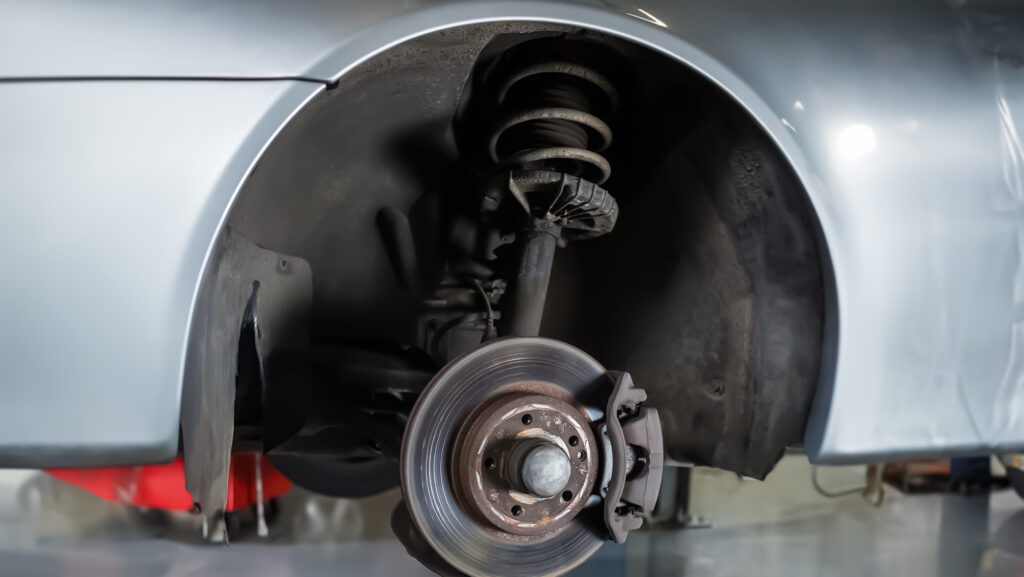When it comes to ensuring your car’s safety and performance, shocks and struts play a crucial role. Shocks and struts are essential components of your vehicle’s suspension system that help absorb the impact of bumps and uneven road surfaces.
Over time, shocks and struts can wear out, which can compromise your car’s handling, ride comfort, and safety. It’s crucial to know the signs that indicate you may need to replace your shocks and struts. Some common signs include:
- Excessive bouncing and vibrations
- Uneven tire wear
- Difficulty steering or controlling the vehicle
- A noticeable decrease in ride comfort
- A nose-down or nose-up attitude when braking or accelerating
How do Shocks and Struts Work?
To understand why shocks and struts are important for your car’s safety and performance, it’s essential to know how they work.
Shocks and struts are part of your car’s suspension system, which is responsible for maximizing tire contact with the road surface and providing a smooth, comfortable ride. Shocks and struts work together to absorb, dampen, and control the vertical movement of your car’s wheels when traveling over bumps, potholes, and uneven road surfaces.
When your car’s tire hits a bump or encounters uneven terrain, the energy from the impact is transferred to the shocks and struts. The shocks and struts then convert this energy into heat and dissipate it, preventing the car from bouncing or swaying excessively. This helps maintain optimal tire contact with the road, providing better steering and braking control and a smoother ride.
There are different types of shocks and struts available in the market, including twin-tube, monotube, gas-charged, and adjustable shocks and struts. The type of shock or strut you need depends on your vehicle’s make and model, your driving needs, and your budget.
Shocks and struts play a vital role in your car’s handling, ride comfort, and safety. Regular maintenance and replacement of worn-out shocks and struts can help ensure optimal vehicle performance and longevity.
When to Replace Your Shocks and Struts
- Excessive bouncing, swaying, or rocking motion, especially on uneven terrain or when making turns
- Uneven tire wear, which can cause poor traction, decreased fuel efficiency, and shorter tire life
- Leaking fluid, which can indicate a damaged or worn-out seal
- Nose-diving or rear-end squatting during braking or acceleration, which can reduce your car’s braking capacity and cause poor handling
If you notice any of these signs, you should get your shocks and struts inspected by a qualified mechanic. They can perform a thorough inspection of your suspension system and let you know if your shocks and struts need replacement.
Driving with worn-out shocks and struts can cause further damage to your suspension system, steering and braking components, and tires. This can compromise your safety, as well as reduce your car’s fuel efficiency and overall performance.
So, if you’re experiencing any of the above symptoms or suspect your shocks and struts may be worn out, don’t wait to get them inspected and replaced if needed to ensure your safety, and avoid costly repairs down the road.
How to Replace Your Shocks and Struts
Replacing your shocks and struts can improve your car’s handling, ride comfort, and safety. Here are some general steps involved in replacing your shocks and struts:
- Jack up the car and remove the wheels
- Remove the old shocks and struts
- Install the new shocks and struts
- Lower the car and test the new suspension system
It’s important to note that the specific steps involved in replacing shocks and struts can vary depending on your vehicle’s make and model. It’s also recommended to consult your car owner’s manual or a qualified mechanic for specific instructions.
To replace shocks and struts, you may need some special tools and equipment, such as a jack, jack stands, ratchet, sockets, torque wrench, and spring compressor. It’s important to use the right tools for the job and follow safety precautions to prevent injury or damage to your car.
Here are some tips and precautions to follow during the replacement process:
- Wear appropriate safety gear, such as gloves and protective eyewear
- Follow the instructions provided by the manufacturer or mechanic
- Inspect other suspension components while you’re at it, as they may need replacement as well
- Follow torque specifications when tightening the nuts and bolts of the shocks and struts
- Get an alignment check after replacing shocks and struts to ensure proper tire wear and handling
DIY vs Professional Replacement
When it comes to replacing your shocks and struts, you have to make a choice between DIY replacement and professional replacement. Here is a comparison of the costs and warranties of these options, as well as the skills, time, and resources required for a DIY replacement:
Skills, Time, and Resources
DIY replacement requires mechanical knowledge, skills, and experience, as well as special tools and equipment. If you’re a DIY enthusiast, you may have the necessary skills to replace shocks and struts. However, the process can be time-consuming and challenging, especially if you encounter unexpected issues. You may also need to buy or rent tools and equipment, such as a jack, jack stands, ratchet, sockets, torque wrench, and spring compressor.
On the other hand, professional replacement doesn’t require any mechanical knowledge or skills. A qualified mechanic can replace shocks and struts quickly and effectively, using their expertise and tools. This can save you time, hassle, and the need to buy tools and equipment you may never use again.
Costs and Warranties
The cost of replacing shocks and struts can vary depending on your vehicle’s make and model, the quality of the parts, and whether you choose to DIY or professional replacement.
DIY replacement can save you money by avoiding labor costs. However, you may end up spending more if you encounter unexpected issues or if you need to buy or rent tools and equipment. Additionally, if you make a mistake during the replacement process, you may end up damaging other components, which can be costly to repair.
Professional replacement can be more expensive than DIY replacement due to labor costs. However, it offers the advantage of a warranty. Most professional mechanics provide warranties on the parts and labor used in the replacement, which can give you peace of mind and save you money in the long run.
Both DIY and professional replacement have their pros and cons. If you have the skills, knowledge, and resources, DIY replacement can save you money and provide a sense of accomplishment. However, if you’re not comfortable with DIY replacement or you don’t have the time, skills, or resources to do it properly, hiring a professional mechanic is a smart choice. Just make sure to choose a reputable, qualified mechanic who can offer you a good warranty on the replacement parts and labor.
Choosing the Right Shocks and Struts
Choosing the right shocks and struts for your car can provide you with maximum comfort, handling, and safety. Here are some factors to consider when selecting the right shocks and struts for your vehicle:
Driving Style and Habits
Your driving style and habits play a significant role in the type of shocks and struts you need. For example, if you drive on smooth roads, you may not need high-performance shocks and struts. However, if you drive on rough terrain or engage in spirited driving, you’ll need shocks and struts that can handle the stresses of aggressive driving.
Car's Make, Model, and Year
Your car’s make, model, and year also influence the type of shocks and struts you need. Some manufacturers produce shocks and struts that are specifically designed for certain models or years. Look for shocks and struts that are compatible with your car’s suspension system to ensure optimal performance and fit.
Budget and Preferences
Your budget and preferences can also play a role in choosing the right shocks and struts. There are various brands and types of shocks and struts available in the market, ranging from economical to high-performance. Do your research and compare prices and features to find the best shocks and struts that suit your budget and preferences.
Types and Brands
There are different types and brands of shocks and struts available in the market, such as twin-tube, monotube, gas-charged, and adjustable. Each type has its advantages and disadvantages, depending on your driving style and habits.
Some popular brands of shocks and struts include Monroe, KYB, Bilstein, Gabriel, and Rancho. These brands offer a range of products that cater to different driving needs and budgets.
Choosing the right shocks and struts for your car requires careful consideration of your driving habits, the car’s make and model, budget, and preferences. Do your research and choose a reputable brand that meets your needs and enhances your car’s handling, comfort, and safety.
Get Professional Shocks and Struts Replacement from HEART Auto Care
HEART Auto Care provide professional shocks and struts replacement services for car owners looking to replace their shocks and struts. From assessing your driving style to selecting the right shocks and struts, HEART Auto Care technicians have the expertise to ensure your vehicle gets maximum performance and comfort. We will ensure that your suspension system is replaced with the right components to give you improved comfort, handling, and safety while driving. With our prompt and reliable service, you can rest assured that your car’s shocks and struts are in good hands!
Bottom Line
Replacing your car’s shocks and struts is an important part of maintaining its suspension system. By choosing the right shocks and struts for your car, you can enjoy improved comfort, handling, and safety while driving. When selecting the right shocks and struts, consider factors such as your driving style, car’s make/model/year, budget, and preferences. DIY replacement can save money but requires mechanical knowledge and skills; professional replacement may cost more but offers warranties on parts and labor.
We hope this article has given you a better understanding of shocks and struts replacement so that you can make an informed decision when replacing them. Don’t forget to check your shocks and struts regularly to maintain the performance of your vehicle’s suspension system.







